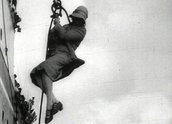


In the Wake of the Bounty (1933)
Synopsis
Charles and Elsa Chauvel follow the path of the Bounty mutineers from Tahiti to the Pitcairn Islands, using dramatised scenes to re-create the events leading up to the mutiny. Most of the second half of the film is a narrated travelogue about the life of the Pitcairn Islanders, descendants of the mutineers and the Polynesian men and women they took with them.
Curator’s notes
Charles Chauvel’s first sound film would largely be a footnote in his career, except that he used Errol Flynn to play Fletcher Christian. Flynn had only appeared on film once before this, in a small part in a British musical. Given his performance here, it’s surprising that his career went any further, but that’s true of most of the film’s performances. Chauvel at this stage of his career had certainly not become a director of actors. The film is an odd mixture of re-creation and travelogue, neither one thing nor the other. The dramatised sequences are prefaced by a scene in a public house frequented by drunken sailors in England in 1810. An old blind fiddler, a survivor of the mutiny, tells his story to the other sailors. Flynn has barely four scenes in which he speaks.
The ship’s arrival in Tahiti allows Chauvel to create an extended sequence featuring beautiful, bare-breasted Tahitian belles, dancing and fraternising with the sailors, during a pleasure-filled six months stay. Having to leave the arms of these ‘dusky maidens’ brings on the mutiny, which is primitively staged. The film then becomes a travelogue, as Chauvel documents the Pitcairn Islands. Some of his footage there is dramatic and very pictorial, and it includes a sequence, shot through a glass-bottomed boat, of a wrecked ship that he says is the Bounty (although it is now thought to be the wreck of another ship, according to Chauvel’s daughter). The trip took place in early 1932 and was shot by Tasman Higgins. The Australian Customs authorities seized the footage and demanded that he excise the bare-breasted Tahitian maidens. Chauvel protested and succeeded in having most of the scenes included.
- Overview
- Curator’s notes
- Video 3 clips

- Principal credits
- Find a copy
- Make a comment
- Add your review



